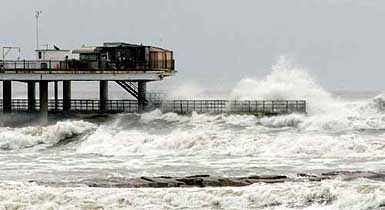
Photo for representational purpose only. AP/PTI
BENGALURU: Scientists have found that Himalayas played a role in the generation of magnitude-9.2 Sumatran earthquake on December 26, 2004, which, together with the massive tsunami that followed, killed more than 2,50,000 people—making it one of the deadliest natural disasters in history.
An international team of scientists, including from the National Centre for Antarctic and Ocean Research in Goa, who wanted to find out what caused such a large earthquake and tsunami have found that the Himalayas, several hundred kilometres away from Sumatra, was an accomplice.
Results of their research, conducted as part of the International Ocean Discovery Programme, have been published in the May 26 issue of the journal Science.
The Sumatran quake originated 30 km below the Indian Ocean floor, along the boundary where the Indo-Australian tectonic plate dives eastward under the Sunda Plate.
Sediment that eroded from the Himalayas and Tibetan plateau over millions of years and transported thousands of kilometres by the Ganges and other rivers had been piling up on the Indian Ocean floor.
Scientists had thought that sediments piling up at plate boundaries, also known as subduction zones, would put the brakes on a rupture, making it less likely to start a huge tsunami.
But an examination of core samples drilled from the sediments feeding into the plate boundary between Indonesia and the Indian Ocean showed something different.
From an oceanographic ship, the research team drilled down 1.5 km below the seabed and sampled the sediment and rocks from the tectonic plate that feeds the Sumatra subduction zone. They measured different properties of the sediments, and ran simulations to calculate how the sediment and rock behaves as it piles up and travels eastward 250 kilometres toward the subduction zone.
The researchers found that, over time, the sheer volume of Himalayan grist was compressing the sediments sufficiently thick to generate temperatures warm enough to strengthen the sediment prior to subduction.
This resulted in a very large fault area and increase in the severity of the earthquake “and helped ensure that the full force of the rupturing fault reached the sea floor, amplifying the tsunami”.
According to the report, the finding has relevance for other subduction zone sites that also have thick, hot sediment and rock such as Cascadia off the Pacific Northwest coast of North America and Makran, which sits in the Arabian Sea off the coast between Iran and Pakistan.
“The authors’ suggestion that the strengthened sediments within the subduction zone off Sumatra may have played a role in facilitating the deadly tsunami “is very interesting,” says C. P. Rajendran, India’s foremost expert in tsunami geology at the Jawaharlal Nehru Centre for Advanced Scientific Research in Bengaluru.
“But this could be only one of the factors,” he told IANS via an email. “There are geometrical considerations. Proximity to the trench and therefore the depth of water are other factors that decide if the earthquake would actually lead to a tsunami.” Rajendran said the insight from this study will indeed help in reevaluating the tsunami hazards off the Makran Coast and Cascadia off the north-western coast of the US which are repositories of huge accumulation of sediments like off Sumatra.
“But it has to be seen how different they are in composition from the sediment derived from Himalayas and thus how they are comparable.” — IANS



























